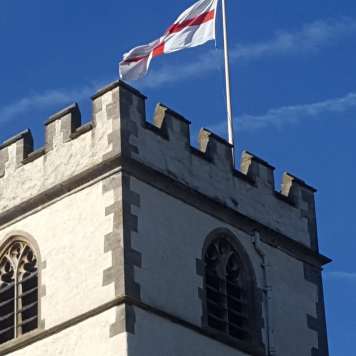Flying the flag
 Here at All Saints we fly a flag at various times throughout the year – St George’s Flag for church events and the Union Flag for civic events. Each year I agree the list of dates with the Rector – mostly the same as the previous year but with a few dates adjusted to account for things like Easter that are ‘movable feasts’.
Here at All Saints we fly a flag at various times throughout the year – St George’s Flag for church events and the Union Flag for civic events. Each year I agree the list of dates with the Rector – mostly the same as the previous year but with a few dates adjusted to account for things like Easter that are ‘movable feasts’.
There were 15 entries in our 2022 schedule, which is quite modest compared with over 30 occasions that the Flag Institute lists as suitable for flying a flag on a church. There are no laws or rules about flying flags on churches – it is subject to the wishes of the incumbent – but there is custom and guidance on what is appropriate.
One new event this year was added quite late, and the request came with its own flag – a Pride Flag. I was told it was a ‘large flag’, and while it might seem like that as you hold it up it is much smaller than the standard flags, which are about 4’x6’. It is also made of plastic sheet rather than the more usual woven polyester or linen fabric, and it just has two eyelets for fixing, instead of the standard toggle at the top and tail at the bottom.
Sometimes a flag is up for a single day, for example the Union Flag on Holocaust Memorial Day (27 January) or the St George’s Flag on Advent Sunday (27 November this year). But sometimes the flag flies for an extended period. At Christmas it’s up from noon on 23rd December until Epiphany (6 January), at Easter it’s from Easter Day until Low Sunday (the week after), and from Ascension Day it’s up until Trinity Sunday.
This year Ascension, which required St George’s Flag from 26 May to 12 June, caused a conflict because we needed to fly the Union Flag during the Platinum Jubilee Weekend (2 – 5 June). So I had to do two rapid swaps between flags and back again. In theory it is possible to fly two flags from the same mast, but it’s not very easy. I had to do similar swaps to mark the King’s proclamation during the period of mourning for the late Queen (with uncertainty over when to change, mentioned last month).
The time of day to raise and lower a flag is also subject to custom. Pedantically it should be raised first thing in the morning and lowered at sunset every day, but that’s not very practical in a building like a church. Generally I raise it the evening before the first day and lower it on the evening of the last day, which for much of the year means it goes up and down during or near the hours of darkness.
I don’t know how long All Saints has been flying flags. The current flag pole is in the northwest corner of the tower, and the wooden ‘root’, which extends below the tower roof to anchor the pole, is inscribed: ‘FB AP PAINTED FLAG POLE MARCH 5 1910’. Assuming that was a repaint it must have been there for some years before.
The drawings of the church in 1812 and 1832 don’t show any flag pole. So I suspect the pole dates from some time during the late 19th century, possibly added in during the restorations in the 1860s or 1870s.
Some time since then the external part of the pole must have been replaced because to need painting in 1902 it must have been wood, whereas now it is a synthetic material.
To stop it being blown over the pole is braced with three diagonal iron bars bolted to the raised central part of the tower roof.
John Harrison (October 2022)



 Here at All Saints we fly a flag at various times throughout the year – St George’s Flag for church events and the Union Flag for civic events. Each year I agree the list of dates with the Rector – mostly the same as the previous year but with a few dates adjusted to account for things like Easter that are ‘movable feasts’.
Here at All Saints we fly a flag at various times throughout the year – St George’s Flag for church events and the Union Flag for civic events. Each year I agree the list of dates with the Rector – mostly the same as the previous year but with a few dates adjusted to account for things like Easter that are ‘movable feasts’.